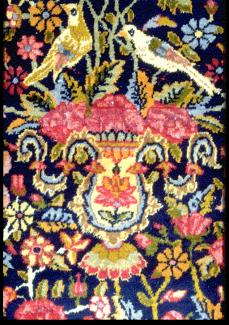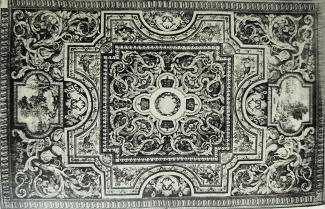|
| |
|
Rug, as ancient as mankind itself, always has been bound to its evolution, as witnessed by its weaves, knots, colors, symbols and design.
Before they invented textiles, men used animal hides to protect themselves from the cold (these skins were used as clothes, floor coverings and hangings meant to cut drafts). As time went by, the planet warmed up and that change brought about the germination of a flora which in no time enabled men to grow cotton and linen. Imitating the intertwined tree branches, they wove the threads gathered from these plants, and thus manufactured textiles.
Textiles were soon to evolve, their degree of sophistication following closely in the steps of civilization itself. Their former utilitarian use was soon paired with such attributes as glamour, luxury, comfort.
Si les Egyptiens avaient sans doute des tapis "mêmEgypt, Chaldea, Minor Asia, Persia, China were the cradle of mankind's first civilization and their highly refined textiles soon became adorned with gems, interwoven with golden and silvery threads. The use of rugs was known to the Egyptians and most probably the use of woolen rugs as well. Diodora of Sicily has reported that the sacred animals were covered with them and a small statue of the god Apis, in the Louvre Museum is known to wear a carpet on his shoulders. For ages, however, there has been a constant confusion between carpets, tapestries and brocades (or embroidered materials) in the Greek and Roman spheres, and until the 14th century in France itself. |
| |
|
|
Le tapis remonte à la plus haute antiquité. Lié à l'histoire de l'évolution humaine, il est le témoignage de ses progrès.
D'abord l'utilisation des peaux de bêtes précéda celle des tissus : ne fallait-il pas se protéger du climat rigoureux ? Leur rôle ne s'arrêtait pas là. Elles isolaient l'entrée des huttes, jetées sur le sol elles en tempéraient la rudesse. Dès qu'une température plus chaude fondit sur les glaces et réveilla une Nature prête à éclore, les hommes connurent le coton, le lin. A l'imitation, des branchages, ils entrecroisèrent les fils. Ainsi, très lentement, naquit l'usage du textile.
Puis vint le goût de la parure, du luxe et du confort. L'Egypte, la Chaldée, l'Asie mineur, la Perse, la Chine, sont le berceau des premières civilisations. Très tôt ils connaissent l'étoffe, y mêlent les fils d'or et d'argent.
Si les Egyptiens avaient sans doute des tapis "mêmes des tapis de laine" puisque Diodore de Sicile nous apprend qu'on en couvrait les animaux sacrés et que Monsieur de Ronchaud nous dit qu'on possède au Louvre une statuette du dieu Apis avec un tapis figuré sur le dos, dans le monde Grec et Romain et jusqu'au XIVeme siècle en France même, il y eut confusion entre les termes tapis, tapisseries, étoffes brodées. |
| |
 |
| Kerman, 19th century (Close-up) |
|
The Egyptian rugs were made of linen and byssus. Hebrews who were fond of beautiful rugs must have derived their knowledge from the Egyptians. Their religious feasts were resplendent; the Queen of Sheba visiting Solomon, offered him magnificent present: "...the purple from Sur, the veils from Assur, the silken textiles from Lebanon, the brocades from Sham, the rugs from Ma-Wara-Nuahr, the clothes from Khorasan, the fruits from Iraq...".
The beauty of woven materials from Persia and Assyria was unparalleled. According to Pliny variegated color materials were qualified as "Babylonian", in homage to the famous manufactures they originated from. Xenophon has reported that in order to soften their sleeping commodities, Persians had the feet of their beds rest upon thick rugs.
Phrygians, Lydians, Phoenicians exported textile master pieces throughout the ancient world; the famous Smyrna (to-day's Izmir) rugs were specimens of these.
All these navigators introduced the rug in Greece. Telemachus set some complex textile work underneath the feet of Athena, Helena embroidered tapestries (Odysseus IV), while Penelope wove (and unwove) her linen. Homer's Illyad mentions several high tufted rugs.
The East was the greatest rug initiator of all time.
The art of the rug was known in Gaulle. Rugs and refined textiles adorned the Middle Ages; thanks to trade, fairs, crusades, travels they were soon introduced into European homes. Pilgrims travelled East. Jerusalem, Cairo, Famagusta were at different times the resplendent storehouses of luxury bound for Venice, Genoa and the Spanish peninsula. |
| |
|
|
Les tapis d'Egypte étaient faits de lin, de byssus. Quant aux Hébreux, ils aimaient les jolis tapis. Ils durent apprendre l'art des Egyptiens. Leurs fêtes religieuses étaient luxueuses ; la reine de Saba faisait à Salomon de somptueux cadeaux : "La pourpre de Sour, les gazes d'Assour, les soieries du Liban et les brocards de Cham, les tapis du Ma-Wara-Nuahr, les robes de Khorassan, les fruits d'Irak" ...
C'est en Perse, en Assyrie, que la beauté des étoffes semble avoir atteint un degré tout particulièrement élevé. Pline nous enseigne que les tissus de couleurs variées étaient appelés "Babyloniens" en l'honneur des célèbres manufactures qui les produisaient. Xénophon raconte que pour se coucher mollement, les Perses avaient soin de faire porter les pieds des lits sur des tapis.
Phrygiens, Lydiens, Phéniciens colportaient dans tout le monde ancien les chefs-d'œuvre du textile, Les fameux tapis de Smyrne en gardent la mémoire.
Tous ces peuples firent connaître les tapis aux Grecs. Sous les pieds d'Athëné Télémaque place un tissu d'un travail varié, Hélène travaille à des tapisseries, Pénélope tisse sa toile (Odyssée IV). L'Iliade, elle, mentionne plusieurs fois les tapis "velus".
L'Orient a été le grand initiateur.
En Gaule l'art du tapis ne périt point. Tapis et belles étoffes conquièrent le Moyen-Age : foires, croisades, commerces. Des pèlerins parcourent l'Orient. Jérusalem, le Caire, Famagouste sont de vastes entrepôts d'un trafic entretenu avec les ports d'Italie, d'Espagne. |
| |
 |
|
|
Ever since that time rugs have been in great demand in the Western world.
The inventory of Charles V (1343) lists 143 carpets. In 1430, Bruges was covered with rugs to honor the entrance of Isabelle of Portugal. In the 17th century, Louis XIII while entertaining the ambassador of Turkey kept watching his guest, for fear that the latter would tread upon "his" rug.
The history of rugs throughout the ages is closely related to that of contemporary mores. At first a basic requirement of everyday life, the rug increasingly became a luxury commodity.
Its production likewise expanded. Rugs were said to be either from England of from Turkey ('The French poet J. de La FONTAINE : "...sur un tapis de Turquie, le couvert se trouva mis…" The Town Rat and the Field Rat). Rugs were everywhere to be seen : on floors naturally, but also upon tables, mantel pieces and benches.
From 1550 onwards, the first Royal rug workshops were created in France. Two patrons of the arts, Francis I, and later, Henry II founded manufactures which were directed by the most skillful craftsmen of their time. The first one, located Place des Tournelles became later on the "Gobelins" manufacture headed from 1604 onwards by Pierre Dupont.
In 1627, it settled on the Hill of Chaillot, on the location of a former soap manufacture, "la Savonnerie". Dupont's collaborator, Simon Lourdet, executed in 1659 a carpet in the "Turkish manner", which the Queen immensely admired.
We should express our gratefulness to the very keen observers who, braving the invading mediocrity of mass-produced Eastern carpets which literally smother today's Western world, keep up the flame of a thousand-year-old craft, and help separate the wheat from the chaff. |
| |
|
|
Ever since that time rugs have been in great demand in the Western world.
The inventory of Charles V (1343) lists 143 carpets. In 1430, Bruges was covered with rugs to honor the entrance of Isabelle of Portugal. In the 17th century, Louis XIII while entertaining the ambassador of Turkey kept watching his guest, for fear that the latter would tread upon "his" rug.
The history of rugs throughout the ages is closely related to that of contemporary mores. At first a basic requirement of everyday life, the rug increasingly became a luxury commodity.
Its production likewise expanded. Rugs were said to be either from England of from Turkey ('The French poet J. de La FONTAINE : "...sur un tapis de Turquie, le couvert se trouva mis…" The Town Rat and the Field Rat). Rugs were everywhere to be seen : on floors naturally, but also upon tables, mantel pieces and benches.
From 1550 onwards, the first Royal rug workshops were created in France. Two patrons of the arts, Francis I, and later, Henry II founded manufactures which were directed by the most skillful craftsmen of their time. The first one, located Place des Tournelles became later on the "Gobelins" manufacture headed from 1604 onwards by Pierre Dupont.
In 1627, it settled on the Hill of Chaillot, on the location of a former soap manufacture, "la Savonnerie". Dupont's collaborator, Simon Lourdet, executed in 1659 a carpet in the "Turkish manner", which the Queen immensely admired.
We should express our gratefulness to the very keen observers who, braving the invading mediocrity of mass-produced Eastern carpets which literally smother today's Western world, keep up the flame of a thousand-year-old craft, and help separate the wheat from the chaff. |
|
| |
|
|
 |
|
|
|
Kerman XIX century Close up
|
|
|
|
|
| |
|
 |
|
|
|
Kerman XIX century Close up
|
|
|
|
|
 |
From Monday to Sunday, by appointment - Phone number : +33 (0)1 42 65 62 30. |
|
Rugs expertise with a view to successions • Rugs restoration workshop • Maintenance and cleaning of ancient rugs • Sale and purchase of ancient rugs • Quality and authenticity of works of art and ancient rugs offered in the gallery • Service of sworn expertise for succession, insurance, sharing or estimate Oriental rugs • Old or rare rugs • Antique carpets for sale • Oriental carpets • Persian carpets • Turkish carpets • Caucasian carpets • Precious carpets • Silk carpets • Magic carpets • Tribal carpets • Persian carpets • Turkish carpets • Caucasian carpets • Carpet appraisal • Valuation of antique and original carpets • Carpet maintenance • Carpet repair and cleaning • Decorative carpets • Carpet videos ... |
|
|
|
Rugs expertise with a view to successions • Rugs restoration workshop • Maintenance and cleaning of ancient rugs • Sale and purchase of ancient rugs • Quality and authenticity of works of art and ancient rugs offered in the gallery • Service of sworn expertise for succession, insurance, sharing or estimate Oriental rugs • Old or rare rugs • Antique carpets for sale • Oriental carpets • Persian carpets • Turkish carpets • Caucasian carpets • Precious carpets • Silk carpets • Magic carpets • Tribal carpets • Persian carpets • Turkish carpets • Caucasian carpets • Carpet appraisal • Valuation of antique and original carpets • Carpet maintenance • Carpet repair and cleaning • Decorative carpets • Carpet videos ...
|
|
|
|

|